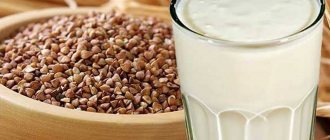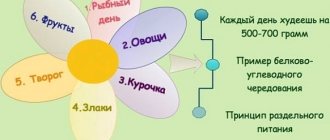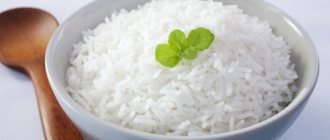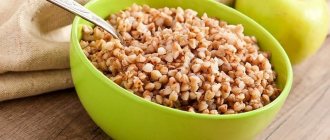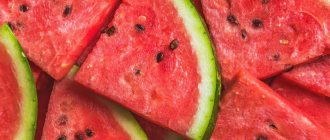Rules for observing a fasting day on buckwheat
Before you start a diet, you need to prepare in advance. You should avoid high-calorie foods: fried, salty, store-bought convenience foods, baked goods and sweets.
First of all, you need to choose the right main product. In stores you can find several types of buckwheat: brown, green, whole or crushed.
“Nutritionists advise choosing unroasted whole grain cereals, which contain more beneficial microelements and vitamins.”
Fasting day on buckwheat, structured as follows:
- Daily calorie content is 800-900 kcal.
- The main method of preparing the dish is steaming.
- Food is consumed in small quantities, 5-6 times during the day.
- It is important to drink enough fluid - 1.5-2.5 liters. You can drink plain water, herbal infusions, and tea.
- It is necessary to exclude intensive sports training and active recreation.
How to do it correctly?
Rapid weight loss on buckwheat is not a myth. But in order to achieve a positive result, you need to know the rules for carrying out a fasting day. Fewer deviations from nutritionist recommendations will ultimately amazingly transform your appearance and improve your intestinal function.
- For a fasting day, both the traditional brown variety of buckwheat is suitable (moreover, you need to choose a grain that is lighter in color - it has been fried less, which means it retains more useful substances in the composition), and green - it has even more benefits, but it has a specific taste , which may not appeal to everyone.
- The most suitable way to prepare the main dish for a fasting day is steaming. Boiled buckwheat is also useful, and a fasting day is also practiced on it, but the effectiveness is much lower.
- During a fasting day, buckwheat can be supplemented with other products, although their variability is limited by nutritionists to dairy products, apples and vegetables.
- Before you start a fasting day, you need to prepare your body - reduce the consumption of junk food (fried, fatty, smoked, sweet, baked goods) for a couple of days and gradually reduce the amount of food consumed (subject to large portions).
- Throughout the fasting day you need to drink clean water without gas. Its total volume should be at least 1.5 liters.
- The last meal is no later than 19 pm.
- Compliance with a fasting day also implies the absence of contraindications when consuming buckwheat. You should definitely familiarize yourself with them before starting the diet.
- Buckwheat fasting day is one of the few varieties acceptable during pregnancy, but in this case there are a number of features that must be taken into account.
How to cook buckwheat?
- The evening before the fasting day, buckwheat must be soaked in hot water.
- It should be covered loosely and left overnight.
- It is prohibited to salt, sweeten or add other foods (nuts, dried fruits, fresh fruits, vegetables and spices) to buckwheat.
- In the morning, the resulting porridge can already be consumed.
Cooking instructions on video
How much cereal do you need?
For the whole day you will need 250 grams of buckwheat or 1 glass. This amount requires 2 glasses of water. Steamed buckwheat should be divided into 5 equal portions, which will need to be consumed throughout the fasting day, taking equal breaks between them.
How to cook buckwheat for a fasting day
Preparing the right product is half the battle; it also needs to be prepared correctly. The daily norm is 250 g of dry cereal.
Be sure to read: Diets for losing weight on the stomach and sides: menu, permitted and prohibited foods
For a fasting day, porridge cooked in the usual way is not used. It is recommended to steam cereals for consumption on the eve of the intended unloading.
For this you will need:
- a glass of whole buckwheat;
- boiling water -500 ml.
How to cook:
- Take a deep bowl, pour grain into the bottom, fill with hot water;
- Cover with a lid and wrap with a thick towel;
- Leave the contents to swell for a day;
- The dish must be divided into equal portions and consumed every 2.5-3 hours.
“It is forbidden to add salt to the finished porridge or add any seasonings, sauces, sugar, butter or vegetable oil.”
Uncooked kernels are quite heavy food for the stomach. People with gastrointestinal diseases (colitis, pancreatitis, etc.), pathologies of the vascular system (varicose veins, hemorrhoids, etc.) should approach buckwheat unloading with caution. This version of the mono-diet is also contraindicated for pregnant, lactating women, and persons with individual intolerance to this ingredient.
Contraindications
Buckwheat is a dietary food and has no obvious contraindications. But in everything you need to know when to stop, since overeating can cause a feeling of heaviness and a deterioration in overall well-being. You should not plan to unload during depression and the menstrual cycle. If the kefir option is meant, then choose a day off so that you can be at home. This is due to the laxative effect of the product.
During pregnancy, such procedures are contraindicated for the first 28 weeks. In the future, it is better to carry them out after medical consultation and with extreme caution so as not to harm the child. Acceptable frequency is no more than once every 2 weeks.
Despite all the benefits of such fasting days, it is not recommended to do this in a number of cases:
- stomach and duodenal ulcers;
- gastritis with high acidity;
- allergy to individual components in the composition.
It is not advisable to combine such days with intense sports activities. Walking in the fresh air, cycling, or light jogging will be safe and beneficial.
Fasting day on buckwheat: menu for the day
Approximate diet of buckwheat-vegetable day
Morning:
- buckwheat;
- cabbage salad dressed with lemon juice;
- green tea.
Snack:
One fresh carrot.
Dinner:
- a portion of porridge;
- Grated boiled beets.
Afternoon snack:
Salad of tomato, celery and radish (can be dressed with natural yoghurt).
Evening:
- porridge;
- cucumber slices;
- tea with mint.
You need to drink enough water per day. You should have dinner no later than 3-4 hours before bedtime.
Beneficial properties of buckwheat
- The rich vitamin and mineral composition (exceeding similar indicators of other types of cereals by 2-3 times) serves as an indication for the inclusion of buckwheat in the diet.
- 2/3 of the fats in buckwheat are vegetable, polyunsaturated. Eating them normalizes fat (lipid) metabolism and thereby helps reduce blood cholesterol levels. Accelerating fat metabolism, in turn, promotes weight loss.
- The proteins that make up buckwheat are rich in amino acids, which brings buckwheat closer to legumes (peas, beans, beans) and even gives grounds to compare it with meat (in terms of protein content).
- Buckwheat contains a lot of easily digestible carbohydrates and fiber, which do not take part in the process of fat formation, but, on the contrary, accelerate the basal metabolism. That is why buckwheat promotes weight loss, despite its high calorie content.
- The content of lysine (an amino acid in the presence of which calcium is absorbed) makes buckwheat an indispensable food product, since it is not produced in the human body.
- Thanks to its low glycemic index, buckwheat can quickly satisfy hunger and give you strength.
- The dietary fiber present in buckwheat helps cleanse the intestines, improve digestion and strengthen the walls of blood vessels.
Now it’s worth talking about what fasting days are and why we need them.
How much can you lose on buckwheat fasting?
By strictly adhering to the rules, you can lose 0.5-2 kg per day. However, you still shouldn’t count on rapid weight loss. The main task of the fasting day is to prepare the body to switch to the correct diet.
Be sure to read: One-day fasting on water: how to fast correctly, who is contraindicated, a way out
Daily food restriction allows you to improve intestinal function, improve metabolism, and cleanse the body of accumulated toxins and waste.
What kind of fasting day is this?
A fasting day involves partial or complete refusal of food. Unloading tasks: to give the body a break from food, to return to normal after periods of overeating, to get rid of a few extra pounds.
Weight loss occurs by removing excess fluid from the body and cleansing the intestines of waste and toxins. Nutritionists, based on individual data and the patient’s health status, prescribe unloading for problems with the heart, blood vessels, liver, kidneys, during periods of exacerbation of diseases of the gastrointestinal tract, musculoskeletal system.
In our case, steamed buckwheat and apples are eaten for 1-3 days. The effectiveness of the technique is based on limiting carbohydrates and saturating the body with proteins. On average, the energy value is 500 kcal per day. During this time, it is advisable to limit any other foods in the diet.
Essence and principle of operation
The combination of apples and buckwheat guarantees quick and long-lasting satiety. Apple fruits and buckwheat are low in calories, contain virtually no fat, but are rich in proteins, amino acids, vitamins and minerals, which are so important for satiety. The composition contains a lot of plant fiber, which cleanses the digestive tract of toxins, waste, and removes excess fluid from the body.
The functions of fiber are varied:
- increases endurance and performance, which stimulates physical activity and additional calorie burning;
- improves digestion;
- activates metabolism;
- accelerates the process of fat breakdown;
- has a mild laxative effect.
The carbohydrates contained in buckwheat are predominantly complex - starch and dextrins. They are absorbed by the body within a few hours, fill the body with energy and do not turn into new fat reserves.
Apples are a natural diuretic. They effectively remove excess fluid from the body, neutralize swelling, thereby visually reducing body volume, absorb fats and acids in the intestines, reduce cholesterol levels, and create favorable conditions for the proliferation of beneficial microorganisms.
Buckwheat and apples are rich in iron. This is an important trace element that performs a number of functions:
- participates in hematopoietic processes;
- is part of hemoglobin and oxidative enzymes;
- stimulates metabolism inside cells;
- increases body tone;
- supports immunity.
Both products contain many B vitamins, which ensure stable functioning of the nervous system, relieve stress and irritability, and help make dieting easier.
For reference . 100 g of buckwheat and 2-3 fresh ripe apples satisfy the daily requirement of the adult human body for iron (10-30 mg).
